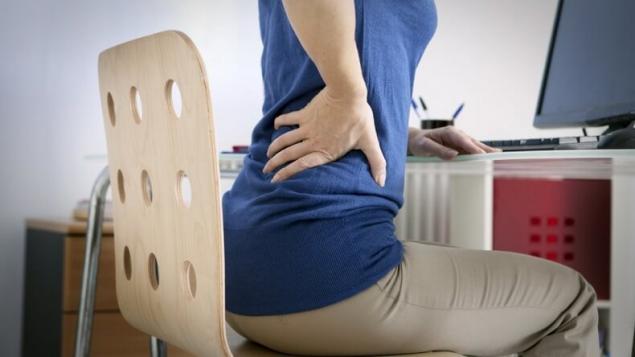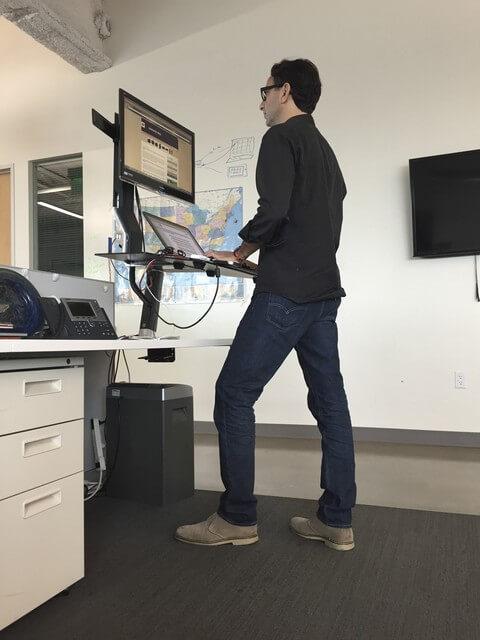507
The price we pay for inactivity
The results of recent studies indicate that passive lifestyle, including prolonged immobile sitting, increase the risk of dozens of chronic diseases, from cancer and diabetes to cardiovascular disease and nonalcoholic fatty liver disease.
Some experts in ergonomics have warned that excessive standing on the feet can also have a negative impact on human health, including lead to increased risk of varicose disease, problems with the spine and legs, as well as diseases of the carotid artery.

"It is extremely important to change activities throughout the day," says Professor of ergonomics at Cornell University, Alan Hedge. "Sit still or stand in all day is equally harmful for health".
For every thirty minutes of office work people should sit about 20 minutes, stand for about 8 minutes, and another two minutes to allocate for traffic and try, says Dr. Hedge. His recommendations are based on the results of the research presented at corporate seminars and publications experts. He argues that a stationary standing on her feet for more than 10 minutes causes a person to bend, that may trigger back problems and other musculoskeletal disorders.
"British journal of sports medicine" published this year a guide for those who lead a sedentary lifestyle, based on the results of the work of an international group of experts, among whom were Dr. Hedge.
A group of researchers came to the conclusion that two to four hours during the working day a person must hold either standing up or in motion. Experiments conducted by NASA have shown that the 16-fold standing for a few minutes a day is an effective strategy to support optimal bone and muscle tissue, says Dr. Hedge.
"Modern scientific studies have shown that if the specificity of the labour of a man is that he is on his feet for more than two hours every day, decrease the risk of developing many serious chronic diseases," says Professor of sports medicine at the British University of Chester Kingsway John Buckley, leader of the group of authors above mentioned guidelines. One of the eight authors of the guide did not hide his "conflict of interest" because he is the owner of the website, which sells special equipment for jobs involving the alternation of work sitting and standing.
The variety "standing jobs" allows office workers to alternate between sitting and standing work

Some research aimed at finding ways to reduce the negative impact of prolonged work in a sitting position. For example, an interesting study, the results of which appeared last week in the "American journal of preventive medicine," was devoted to this phenomenon as "fidgeting", which can be translated into Russian language the word "restless". The researchers analyzed data from the British cohort studies, which was attended by a large number of women around the age of 20 years. Approximately 13 thousand participants were asked to evaluate in points from 1 to 10, the degree of their restlessness. Among women who, because of lifestyle was positioned as the most sedentary, those who did a lot of flailing and showed restlessness, the risk of death did not exceed indicators of women not leading a sedentary lifestyle. At the same time, women who don't have the restless, were at increased risk.
The head of group of authors, Professor of epidemiology nutrition at the British University of Leeds Janet Cade, said that the study helped to identify the relationship between these two factors.
"In order to obtain the benefits of an active lifestyle may not necessarily run at the marathon distance, "suggests Dr. Cade. "It is likely that if a person commits a relatively small amount of movement, it also brings benefit to his health."
Various studies have shown that even regular exercise cannot compensate the negative effect of prolonged sitting during the day. It is a fixed seat causes psychological changes that may provoke the individual genetic factors associated with inflammatory processes and chronic diseases such as diabetes and cardiovascular disease, says Dr. Buckley from the University of Chester. In contrast, in the standing position the muscles aktiviziruyutsya, resulting in excess glucose accumulation in the bloodstream and is absorbed by muscle tissue, he said.
Standing we burn per minute at 0.5-1.0 more calories than sitting. In four hours it will be as much as 240 additional calories burned. Sitting for more than an hour reduces levels of the enzyme lipoprotein lipase that makes calories be directed to creation of fat reserves, and not on muscle activity, said Dr. Hedge.
The impact of prolonged sitting on blood circulation has been the subject of a recent small study, which was attended by 11 young men. The results were published in the journal "Experimental psychology". After six hours of sitting, the activity of the circulation in one of the main arteries located in the legs, was reduced by more than 50 percent. However, after a 10-minute walk it is fully restored, says assistant Professor of nutrition and sports physiology, University of Missouri Jaume Padilla, who led the group of researchers.
"More research is needed to determine whether the decrease in vascular activity during long periods of sitting to long-term complications of the vascular system," says Dr. Padilla.
Scientists are also looking for ways to "force" people to sit less during the day. In an article published in the journal "Health Psychology Review" last week was the overview of various studies that propose 38 possible means "to stand up from the chair." Among the most effective senior lecturer Institute of psychiatry, psychology and neurology London kings College Benjamin Gardner had the following to say: to explain people the benefit of reducing the time stationary seat; to change the workplace, for example, to set a standing or adjustable desks; aim to control the seat to record seat time; create different reasons to people had from time to time to get up.
Most of the procedures which have proven ineffective, was intended to encourage greater physical activity, says Dr. Gardner. "We need treatments that will specifically target the interruption of the seat, as well as procedures that will push people to move more actively," he said.
Professor of medicine of Rochester's Michael Jensen, specializing in the treatment of obesity and diabetes, uses a variety of ways to reduce the length of the seat, which he recommends to his patients. When meeting with one or two patients, he chooses places where you can talk with them during a joint walk instead of sit. However, he says the their patients, who have children that they should use the active play of children as an excuse to spend time in traffic. "You don't have to just sit and watch these games," says Dr. Jensen.
Tiffany Muir, using the "standing" workplace in 2012, says it raises the degree of concentration. This 45-year-old woman working at a biotech company near Boston, says she also insists that most of it was standing, although initially this was due to some embarrassment. "I am an avid runner, but I think that you need more time to spend on your feet, even so sport people like me," she says.
Mark Abouna finds time to stand on his feet while waiting for the train for 25 minutes to work at his PR firm in Boston. "People are fighting for seats, and I'm happy to stand and watch them struggle," says this 28-year-old man. published
P. S. And remember, only by changing their consumption — together we change the world! © Join us at Facebook , Vkontakte, Odnoklassniki
Source: mixednews.ru/archives/88855
Some experts in ergonomics have warned that excessive standing on the feet can also have a negative impact on human health, including lead to increased risk of varicose disease, problems with the spine and legs, as well as diseases of the carotid artery.

"It is extremely important to change activities throughout the day," says Professor of ergonomics at Cornell University, Alan Hedge. "Sit still or stand in all day is equally harmful for health".
For every thirty minutes of office work people should sit about 20 minutes, stand for about 8 minutes, and another two minutes to allocate for traffic and try, says Dr. Hedge. His recommendations are based on the results of the research presented at corporate seminars and publications experts. He argues that a stationary standing on her feet for more than 10 minutes causes a person to bend, that may trigger back problems and other musculoskeletal disorders.
"British journal of sports medicine" published this year a guide for those who lead a sedentary lifestyle, based on the results of the work of an international group of experts, among whom were Dr. Hedge.
A group of researchers came to the conclusion that two to four hours during the working day a person must hold either standing up or in motion. Experiments conducted by NASA have shown that the 16-fold standing for a few minutes a day is an effective strategy to support optimal bone and muscle tissue, says Dr. Hedge.
"Modern scientific studies have shown that if the specificity of the labour of a man is that he is on his feet for more than two hours every day, decrease the risk of developing many serious chronic diseases," says Professor of sports medicine at the British University of Chester Kingsway John Buckley, leader of the group of authors above mentioned guidelines. One of the eight authors of the guide did not hide his "conflict of interest" because he is the owner of the website, which sells special equipment for jobs involving the alternation of work sitting and standing.
The variety "standing jobs" allows office workers to alternate between sitting and standing work

Some research aimed at finding ways to reduce the negative impact of prolonged work in a sitting position. For example, an interesting study, the results of which appeared last week in the "American journal of preventive medicine," was devoted to this phenomenon as "fidgeting", which can be translated into Russian language the word "restless". The researchers analyzed data from the British cohort studies, which was attended by a large number of women around the age of 20 years. Approximately 13 thousand participants were asked to evaluate in points from 1 to 10, the degree of their restlessness. Among women who, because of lifestyle was positioned as the most sedentary, those who did a lot of flailing and showed restlessness, the risk of death did not exceed indicators of women not leading a sedentary lifestyle. At the same time, women who don't have the restless, were at increased risk.
The head of group of authors, Professor of epidemiology nutrition at the British University of Leeds Janet Cade, said that the study helped to identify the relationship between these two factors.
"In order to obtain the benefits of an active lifestyle may not necessarily run at the marathon distance, "suggests Dr. Cade. "It is likely that if a person commits a relatively small amount of movement, it also brings benefit to his health."
Various studies have shown that even regular exercise cannot compensate the negative effect of prolonged sitting during the day. It is a fixed seat causes psychological changes that may provoke the individual genetic factors associated with inflammatory processes and chronic diseases such as diabetes and cardiovascular disease, says Dr. Buckley from the University of Chester. In contrast, in the standing position the muscles aktiviziruyutsya, resulting in excess glucose accumulation in the bloodstream and is absorbed by muscle tissue, he said.
Standing we burn per minute at 0.5-1.0 more calories than sitting. In four hours it will be as much as 240 additional calories burned. Sitting for more than an hour reduces levels of the enzyme lipoprotein lipase that makes calories be directed to creation of fat reserves, and not on muscle activity, said Dr. Hedge.
The impact of prolonged sitting on blood circulation has been the subject of a recent small study, which was attended by 11 young men. The results were published in the journal "Experimental psychology". After six hours of sitting, the activity of the circulation in one of the main arteries located in the legs, was reduced by more than 50 percent. However, after a 10-minute walk it is fully restored, says assistant Professor of nutrition and sports physiology, University of Missouri Jaume Padilla, who led the group of researchers.
"More research is needed to determine whether the decrease in vascular activity during long periods of sitting to long-term complications of the vascular system," says Dr. Padilla.
Scientists are also looking for ways to "force" people to sit less during the day. In an article published in the journal "Health Psychology Review" last week was the overview of various studies that propose 38 possible means "to stand up from the chair." Among the most effective senior lecturer Institute of psychiatry, psychology and neurology London kings College Benjamin Gardner had the following to say: to explain people the benefit of reducing the time stationary seat; to change the workplace, for example, to set a standing or adjustable desks; aim to control the seat to record seat time; create different reasons to people had from time to time to get up.
Most of the procedures which have proven ineffective, was intended to encourage greater physical activity, says Dr. Gardner. "We need treatments that will specifically target the interruption of the seat, as well as procedures that will push people to move more actively," he said.
Professor of medicine of Rochester's Michael Jensen, specializing in the treatment of obesity and diabetes, uses a variety of ways to reduce the length of the seat, which he recommends to his patients. When meeting with one or two patients, he chooses places where you can talk with them during a joint walk instead of sit. However, he says the their patients, who have children that they should use the active play of children as an excuse to spend time in traffic. "You don't have to just sit and watch these games," says Dr. Jensen.
Tiffany Muir, using the "standing" workplace in 2012, says it raises the degree of concentration. This 45-year-old woman working at a biotech company near Boston, says she also insists that most of it was standing, although initially this was due to some embarrassment. "I am an avid runner, but I think that you need more time to spend on your feet, even so sport people like me," she says.
Mark Abouna finds time to stand on his feet while waiting for the train for 25 minutes to work at his PR firm in Boston. "People are fighting for seats, and I'm happy to stand and watch them struggle," says this 28-year-old man. published
P. S. And remember, only by changing their consumption — together we change the world! © Join us at Facebook , Vkontakte, Odnoklassniki
Source: mixednews.ru/archives/88855
As a C bypass honors in business
It is a myth that needs to track users to make money on the web search























